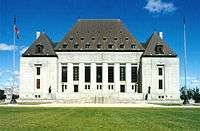Please tell us which country and city you'd like to see the weather in.
Claremont, Ontario
Claremont is a Southern Ontario community located in the north part of the City of Pickering, Ontario, Canada. Historically, Claremont was part of Pickering Township, Ontario County, Ontario until 1974 when Ontario County was amalgamated into the Regional Municipality of Durham established at that time.
It is one of many rural villages with suburban type housing mixed with older, historic buildings in the Greater Toronto Area. Brock Road, the main north-south Regional road in the area was realigned to bypass the village to the east in 1970. Claremont is situated just below the Oak Ridges Moraine in the Greenbelt. Typical of the moraine countryside, around 50 to 70% of the land area around Claremont is forested. The remaining land around the village is wooded farmland and streams.
Until the establishment of regional government in 1974, the municipal offices of the former Township of Pickering were located in Claremont.
Access to and traffic through Claremont increased greatly with the completion of the eastern extension of the Highway 407 highway, terminating at the Brock Road exit which opened in 2001.

Ontario
Ontario (![]() i/ɒnˈtɛərioʊ/) is one of the ten provinces of Canada, located in east-central Canada. It is Canada's most populous province by a large margin, accounting for nearly 40 percent of all Canadians, and is the second largest province in total area. Ontario is fourth largest in total area when the territories of the Northwest Territories and Nunavut are included. It is home to the nation's capital city, Ottawa, and the nation's most populous city, Toronto.
i/ɒnˈtɛərioʊ/) is one of the ten provinces of Canada, located in east-central Canada. It is Canada's most populous province by a large margin, accounting for nearly 40 percent of all Canadians, and is the second largest province in total area. Ontario is fourth largest in total area when the territories of the Northwest Territories and Nunavut are included. It is home to the nation's capital city, Ottawa, and the nation's most populous city, Toronto.
Ontario is bordered by the province of Manitoba to the west, Hudson Bay and James Bay to the north, and Quebec to the east, and to the south by the US states of (from west to east) Minnesota, Michigan, Ohio, Pennsylvania and New York. All of Ontario's 2,700 km (1,678 mi) border with the United States follows inland waterways: from the west at Lake of the Woods, eastward along the major rivers and lakes of the Great Lakes/Saint Lawrence River drainage system. These are the Rainy River, the Pigeon River, Lake Superior, the St. Marys River, Lake Huron, the St. Clair River, Lake St. Clair, the Detroit River, Lake Erie, the Niagara River, Lake Ontario and along the St. Lawrence River from Kingston, Ontario, to the Quebec boundary just east of Cornwall, Ontario.
List of Senators of Canada representing Ontario
This is a list of past and present Senators of Canada representing the province of Ontario. Ontario has had an allocation of 24 senators since the time of Confederation. The province is also one of four regional Senate divisions under Section 26 of the Constitution Act that allows for the expansion of the Senate by one or two senators per region.
Current
Notes:
1 Senators are appointed to represent Ontario. Each senator may choose to designate a geographic area within Ontario as his or her division.
2 Senators are appointed by the Governor-General of Canada in the Queen's name on the recommendation of the prime minister.
3 Division designated as Toronto Centre from 000000001984-01-13-0000January 13, 1984 to 000000002001-02-14-0000February 14, 2001 and Toronto Centre-York from 000000002001-02-15-0000February 15, 2001 to the present.
Historic
Notes:
1 Senators are appointed to represent Ontario. Each senator may choose to designate a geographic area within Ontario as his or her division.
2 Senators are appointed by the Governor-General of Canada in the Queen's name on the recommendation of the prime minister; the initial 24 senators were named by a Royal Proclamation at the time of confederation.

Ontario (Human Rights Commission) v Etobicoke (Borough of)
Ontario (Human Rights Commission) v Etobicoke (Borough of), [1982] 1 S.C.R. 202 is a leading Supreme Court of Canada decision on age discrimination. Several firemen challenged a mandatory retirement policy under the Ontario Human Rights Code. The Court found that the employer did not sufficiently justify the policy as a bona fide occupational requirement.
Background
Harold Hall and Vincent Gray were firemen in the borough of Etobicoke, Ontario. As part of the collective agreement between the borough and the union, all firefighters were required to retire at the age of 60. When Hall and Grey were forced to retire they brought a complaint for age discrimination under section 4(1) of the Ontario Human Rights Code which prohibited discrimination in recruitment or dismissal based on age among other grounds.
The respondents defended their actions by arguing that the rule was a bona fide occupational requirement (BFOR). Namely, that the rule was required to maintain an acceptable standard for firefighting.
Radio Stations - Ontario
SEARCH FOR RADIOS
Podcasts:

